Chapter 13 - Secondary Function Harmony
- Unstable - How active or restless the note is.
- Most active note - Scale degree 7, the leading tone, Ti.
- Second most active tone - Scale degree 4, subdominant pitch, Fa.
Secondary Dominants and Leading Tones
Recognizing Secondary Dominants and Leading Tones
Tonicization - Borrowing one or two chords from a closely related key to heighten the harmonic intensity and color.
Leading tone relationship - When an accidental resolves upward by a half step.
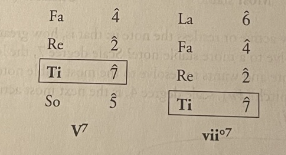
If you have an accidental that resolves upward by a half step, then you have a leading cone relationship in a new key.
If the altered note is the third of the borrowed chord and analyze as a major triad or major-minor seventh chord, then you have a chord functioning as a dominant (V or V7) in another key.
- Check to see whether the secondary chord would be dominant (V) of the resolution chord. If so, then you have a secondary dominant.
If the altered note is the root of a diminished triad or seventh chord, then you have a secondary chord functioning as a leading tone vii° or vii°7 in another key.
- Check to see whether the chord would indeed be vii° of the resolution chord. If so, then you have a secondary leading tone.
Building and Resolving Secondary Dominants and Leading Tones
A secondary chord symbol has two parts:
- The bottom of the chord symbol - Represents the temporary tonic.
- The chord symbol above the slash - Represents the chord quality, inversion, and function of this borrowed chord in relation to the temporary tonic.

Building Secondary Dominants and Leading Tones
Look at the chord symbol below the slash; that is your new tonic.
Spell the chord as requested above the slash including correct inversion in the key of the new tonic.
Resolve the secondary chord to the new tonic following the rules of resolution for that key (Ti goes to Do and Fa goes to Mi).
Recognize the leading-tone relationship that occurs between the altered note Ti and the note it leads to Do in the new key.
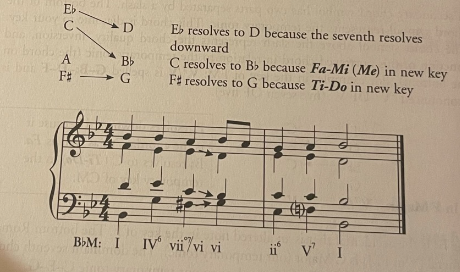
Hearing and Notating Secondary Dominants and Leading Tones
If the chromatic note is an essential member of the chord that leads to a non-tonic chord and if it has dominant function, then there’s a secondary relationship resolving to a temporary tonic.
Most common way to notate what you hear:
- Write the Roman numeral of the resolution chord (the temporary tonic) first.
- Listen to the chromatic chord for quality and inversion.
- Write that Roman numeral in the key of the next chord.
- Add the slash to show the secondary relationship, followed by the Roman numeral of the second chord.
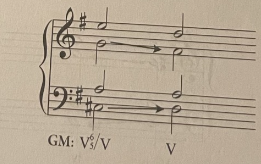
Relating Secondary Function Harmony To Other Skills
Relating Secondary Function to Sight-Singing
- When analyzing a melody for performance, the first thing you should do is determine the mode, tonal center, and appropriate solfege or scale-degree names or numbers.
- If you have a melody that contains a Fi-So, then you probably have a shift of tonal center and tonicization to the key of the dominant.
- Common chords that tend to be tonicized are IV, vi, and ii.
- If the temporary tonic is subdominant, then the leading-tone relationship is not an altered note in a major tonality (it occurs between Mi and Fa). In a minor tonality, Me does the rise to Mi.
- If the temporary tonic is submediant, then the leading-tone relationship is Si to La.
- If the temporary tonic is supertonic, then the tonic is raised.
Relating Secondary Function to Melodic Dictation
- The concept of secondary function overlaps from one process to another.
- See (secondary function) and Perform → Sight-Singing
- Hear (secondary function) and Notate → Melodic and Harmonic Dictation
- Analyze (secondary function) and Create → Score Analysis, Harmonizing a Melody, and Part Writing
Relating Secondary Function to Harmonizing a Melody (FR 7)
An accidental resolving upward by a half step usually signals a leading-tone relationship and a temporary shift to a new tonic.
- The altered note, usually a raised Fi, would be Ti resolving to Do in the new key.
- Ti is the third of a dominant chord or the root of a leading-tone chord and both resolve to tonic.
- This commonly occurs at cadences as predominant functions.
If you have a Fi-So in your melody, then you may harmonize with either a secondary dominant or a secondary leading tone.
If your melody gives you So-Fi-So or Mi-Fi-So, then harmonize the first chord with I 6/4.
- If it’s Fa-Fi-So, harmonize with ii or IV.
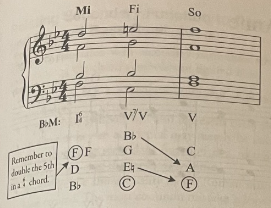
Relating Secondary Function to Harmonic Dictation
Most common melodic patterns containing an accidental
- So-Fi-So
- Fa-Fi-So
If the Fi occurs in the melody, then most likely your chord is in the root position.
If the So-Fi-So pattern is in the bass line and the chord quality is major, then you have a secondary dominant in first inversion because the third of the chord will be Fi and that note is in the bass.
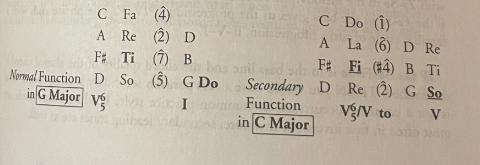
Relating Secondary Function to Part Writing and Figured Bass Realization
- In a major key, a secondary dominant or leading tone will always have an accidental.
- Figured bass symbols will also represent these altered pitches.
- In a minor key, an accidental may merely be another form of minor.
- The secondary function is a relationship between two chords, the second one being the temporary tonic.
- Make sure the chord quality of the Roman numeral symbol is the quality you have created. The most common mistake is leaving out the required accidental.
- The resolution tones in a secondary dominant or a secondary leading tone are based on the temporary tonic and not the original tonic.
- If you have a complete root position secondary chord going to a root position chord, then following the rules of resolution, the temporary tonic chord will be incomplete with three roots, one third and no fifth.
- If you want a complete resolution chord, then leave out the fifth of the secondary chord and double the root.
- Never double Fi or any other accidental when it is the leading tone of the tonicized chord.
- Chromatic harmony - The study of secondary dominants and leading tones.
- When any voice line includes chromaticism, harmonizing those non-diatonic tones requires going out of the key.